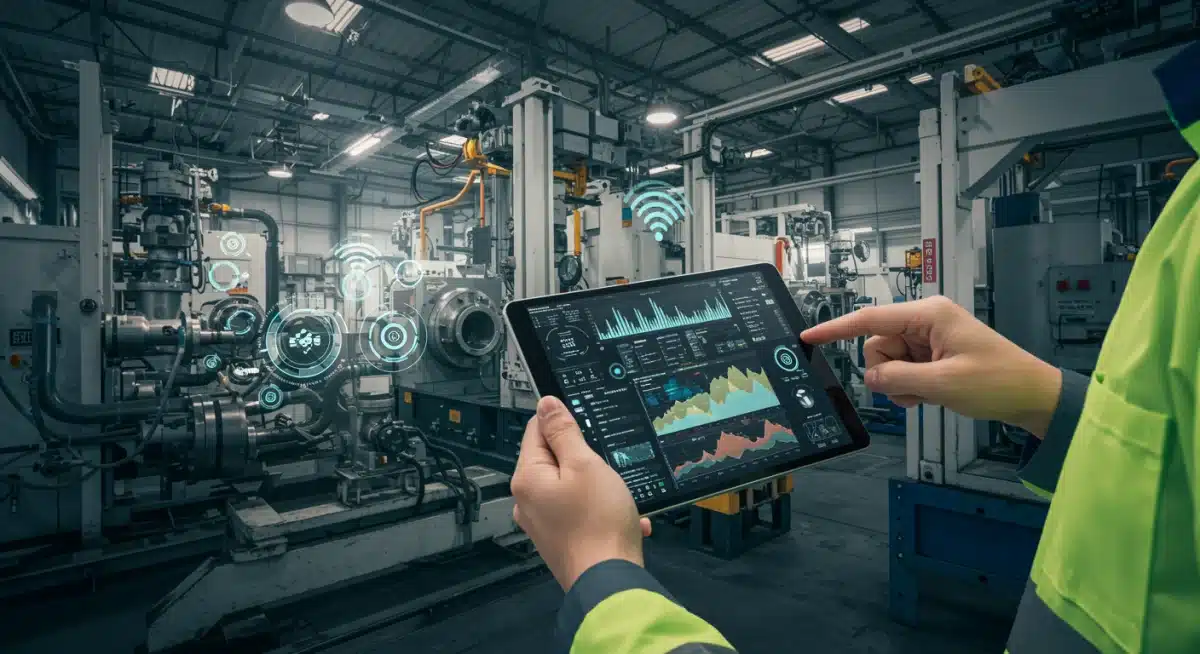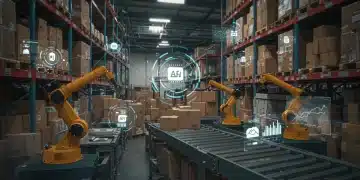Predictive Maintenance with AI: 40% Downtime Reduction for US Manufacturing

US manufacturing is on the cusp of an unprecedented 40% reduction in operational downtime within the next 12 months, leveraging advanced AI-driven predictive maintenance technologies.
The landscape of US manufacturing is undergoing a significant transformation, with a bold prediction emerging: a Predictive Maintenance with AI: Reducing Downtime by 40% for US Manufacturing in the Next 12 Months. This isn’t merely an aspiration; it’s a rapidly unfolding reality as artificial intelligence (AI) fundamentally reshapes how factories operate, promising unprecedented efficiency gains and a competitive edge.
The AI Revolution in Manufacturing Operations
The integration of artificial intelligence into manufacturing processes is no longer a futuristic concept but a current imperative. As of late 2023 and early 2024, AI is rapidly moving from pilot projects to widespread deployment across various sectors of US manufacturing. This shift is primarily driven by the urgent need to optimize operational costs, enhance production reliability, and maintain a competitive stance in the global market. The promise of AI in this context is its ability to analyze vast amounts of data, learn from patterns, and predict equipment failures before they occur, effectively turning reactive maintenance into proactive strategy.
Early adopters are already reporting significant improvements, validating the projections of substantial downtime reduction. These gains are not just theoretical; they are being realized through tangible decreases in unexpected outages and a more efficient allocation of maintenance resources. The data collected from sensors, historical maintenance logs, and operational parameters feeds sophisticated AI algorithms, which then identify subtle indicators of impending issues that human analysis might miss. This predictive capability is the cornerstone of the projected 40% downtime reduction.
Understanding Predictive Maintenance
Predictive maintenance, at its core, is about anticipating equipment failures. Unlike traditional time-based or reactive maintenance, it uses data analytics to determine the optimal time to perform maintenance tasks, extending asset lifespan and preventing costly breakdowns. AI supercharges this approach by:
- Analyzing complex sensor data in real-time.
- Identifying subtle anomalies and deviations from normal operating conditions.
- Forecasting potential failures with high accuracy.
- Optimizing maintenance schedules to minimize disruption.
These capabilities allow manufacturers to schedule interventions precisely when needed, avoiding unnecessary maintenance while also preventing catastrophic failures. The result is a finely tuned operational rhythm where machinery works at peak efficiency with minimal interruptions.
Current Adoption Trends Across US Industries
Recent reports indicate a sharp increase in AI predictive maintenance adoption across diverse US manufacturing sectors. Heavy industries, automotive, aerospace, and even high-tech electronics manufacturing are at the forefront of this technological shift. Companies are investing heavily in sensor technology, data infrastructure, and specialized AI platforms to harness the power of predictive analytics. This widespread adoption underscores the urgent demand for solutions that directly address the economic impact of unplanned downtime.
According to a recent survey by the National Association of Manufacturers (NAM), over 30% of US manufacturers have either implemented or are actively piloting AI-driven predictive maintenance systems, a significant jump from just 10% two years prior. This acceleration is partly due to the decreasing cost of sensor technology and the increasing availability of user-friendly AI platforms that require less specialized data science expertise to deploy. The competitive pressure to reduce operational expenditures and improve output quality is also a major driver pushing companies to embrace these innovative solutions.
Furthermore, the availability of government incentives and grants for adopting advanced manufacturing technologies is encouraging smaller and medium-sized enterprises (SMEs) to explore AI predictive maintenance. These programs aim to bolster US manufacturing competitiveness by fostering innovation and efficiency across the board. The collective momentum from large corporations and SMEs is creating a robust ecosystem for AI integration, making the 40% downtime reduction target seem increasingly attainable.
Key Technologies Driving AI-Powered Predictions
The effectiveness of AI Predictive Maintenance US relies on a suite of interconnected technologies working in harmony. At the foundation are advanced sensor networks that collect real-time data on vibration, temperature, pressure, acoustics, and other critical operational parameters. These sensors, often wireless and IoT-enabled, provide the raw material for AI algorithms to process. The sheer volume and velocity of this data necessitate robust data processing capabilities, often leveraging cloud computing platforms for scalable storage and analysis.
Machine learning algorithms, particularly deep learning and neural networks, form the brain of these systems. They are trained on historical data, including past equipment failures, maintenance records, and operational logs, to identify complex patterns and correlations. These algorithms can detect subtle deviations that precede equipment malfunction, often long before human operators or traditional monitoring systems would notice. The ability to learn and adapt from new data continuously makes these systems increasingly accurate over time.
Core Technological Components
- IoT Sensors: Devices collecting real-time data from machinery.
- Edge Computing: Processing data closer to the source for faster insights.
- Cloud Platforms: Scalable infrastructure for data storage and AI model training.
- Machine Learning Algorithms: Predictive models identifying failure patterns.
- Digital Twins: Virtual replicas of physical assets for simulation and analysis.
The combination of these technologies enables a comprehensive view of asset health, allowing for highly accurate predictions and proactive intervention. Digital twins, for example, create virtual models of physical equipment, allowing simulations of various scenarios and testing maintenance strategies without impacting live operations. This holistic approach is critical for achieving the ambitious goal of a 40% reduction in downtime.
Economic Impact and ROI for Manufacturers
The economic benefits of implementing Predictive Maintenance with AI are substantial and extend far beyond just reducing downtime. For US manufacturers, the return on investment (ROI) is becoming increasingly clear, driving further adoption. By avoiding unexpected breakdowns, companies save significantly on emergency repairs, which are often more costly due to expedited parts, overtime labor, and production losses. The ability to schedule maintenance during planned downtimes or off-peak hours further optimizes resource allocation and minimizes operational disruption.
Beyond direct cost savings, AI predictive maintenance leads to increased asset lifespan. By addressing issues proactively and optimizing maintenance intervals, equipment experiences less wear and tear, delaying the need for costly replacements. This translates into better utilization of capital assets and improved overall equipment effectiveness (OEE). Furthermore, enhanced reliability boosts production capacity, allowing manufacturers to meet demand more consistently and capitalize on market opportunities.


The competitive advantage gained from improved operational efficiency is also a significant factor. Manufacturers who can consistently deliver high-quality products on time and at a competitive cost are better positioned in the market. The projected 40% downtime reduction directly contributes to this advantage, making US manufacturing more resilient and competitive globally. This also means a more sustainable operational model, reducing waste and energy consumption associated with inefficient processes.
Challenges and Solutions in Implementation
While the benefits of AI Predictive Maintenance US are compelling, implementation is not without its challenges. One significant hurdle is the initial investment required for sensor technology, data infrastructure, and AI software platforms. Many manufacturers, especially smaller ones, may find these upfront costs daunting. Another challenge lies in data integration and quality. Legacy systems often produce fragmented or inconsistent data, which can hinder the effectiveness of AI algorithms. Ensuring data cleanliness and interoperability is crucial for accurate predictions.
Addressing Implementation Obstacles
- Cost: Phased implementation, government grants, and SaaS models can reduce initial financial burden.
- Data Quality: Investing in data governance, standardization, and integration tools.
- Talent Gap: Upskilling existing workforce, collaborating with academic institutions, and leveraging external AI expertise.
- Resistance to Change: Clear communication, demonstrating early successes, and involving employees in the transition.
The shortage of skilled personnel capable of deploying and managing AI systems is another critical concern. There’s a growing demand for data scientists, AI engineers, and maintenance technicians with digital literacy. Manufacturers are addressing this by investing in training programs for their existing workforce and collaborating with educational institutions to develop specialized curricula. Overcoming these challenges requires a strategic approach, combining technological investment with organizational change management and workforce development.
However, the solutions are emerging rapidly. Cloud-based AI platforms are making predictive maintenance more accessible and affordable, reducing the need for extensive in-house infrastructure. Furthermore, as more case studies demonstrate clear ROI, the business case for overcoming these challenges becomes stronger, encouraging further investment and innovation in the sector. The focus is now on streamlining deployment and making these powerful tools available to a broader segment of the manufacturing industry.
Future Outlook: Scaling Predictive Maintenance with AI
Looking ahead, the next 12 months are critical for scaling Predictive Maintenance with AI: Reducing Downtime by 40% for US Manufacturing. The initial successes and growing adoption rates are paving the way for widespread implementation across the entire manufacturing ecosystem. The focus will shift from proof-of-concept projects to integrating these systems seamlessly into daily operations, making predictive insights an intrinsic part of maintenance and production planning.
Expect to see further advancements in AI algorithms, making predictions even more precise and actionable. The trend towards explainable AI (XAI) will also grow, allowing maintenance teams to understand why a particular prediction was made, fostering greater trust and adoption. Moreover, the convergence of AI with other Industry 4.0 technologies, such as augmented reality (AR) and virtual reality (VR), will transform how maintenance tasks are performed, providing technicians with real-time, context-aware guidance.
The continuous improvement cycle of data collection, AI model refinement, and operational feedback will drive an accelerating pace of innovation. As more manufacturers share their data (anonymously and securely, of course), collective intelligence will grow, benefiting the entire industry. This collaborative approach will further solidify the US position as a leader in advanced manufacturing, ensuring that the ambitious target of a 40% downtime reduction is not just met but potentially exceeded, setting new benchmarks for global industrial efficiency and productivity.
| Key Point | Brief Description |
|---|---|
| 40% Downtime Reduction Goal | US manufacturing aims to reduce operational downtime by 40% within 12 months using AI predictive maintenance. |
| AI Integration | AI analyzes data to predict equipment failures, transitioning from reactive to proactive maintenance strategies. |
| Economic Benefits | Significant ROI through reduced emergency repairs, extended asset lifespan, and increased production capacity. |
| Implementation Challenges | Initial costs, data quality, and skill gaps are being addressed through phased implementation and training. |
Frequently Asked Questions About AI Predictive Maintenance
Predictive maintenance with AI uses artificial intelligence algorithms to analyze data from machinery sensors, historical records, and operational parameters. It identifies patterns and predicts potential equipment failures before they occur, allowing for proactive maintenance scheduling and minimizing unexpected downtime.
By accurately forecasting equipment malfunctions, AI enables manufacturers to perform maintenance precisely when needed, avoiding costly emergency repairs and unscheduled shutdowns. This proactive approach optimizes resource allocation, extends asset lifespan, and significantly reduces the frequency and duration of downtime events.
Key technologies include IoT sensors for data collection, edge and cloud computing for processing, machine learning algorithms for pattern recognition and prediction, and digital twins for simulation. These components work together to provide a comprehensive and accurate assessment of asset health.
US manufacturers benefit from substantial cost savings by avoiding emergency repairs and optimizing maintenance schedules. They also experience increased operational efficiency, extended equipment lifespan, improved product quality, and enhanced competitiveness in global markets due to more reliable production.
Challenges include initial investment costs, ensuring high-quality data integration from legacy systems, and addressing the skill gap for deploying and managing AI systems. Solutions involve phased implementation, government support, and investing in workforce training and development.
Looking Ahead
The drive towards a 40% reduction in downtime for US manufacturing within the next 12 months through AI predictive maintenance represents a pivotal moment. This aggressive target underscores the confidence in AI’s transformative power and the industry’s commitment to modernization. As implementation scales, the ripple effects will extend beyond individual factories, bolstering national economic resilience and technological leadership. The focus now shifts to widespread adoption, continuous innovation, and the development of a skilled workforce ready to manage this new era of intelligent manufacturing.





